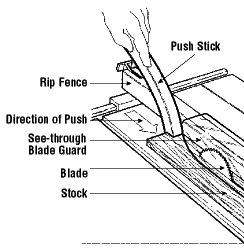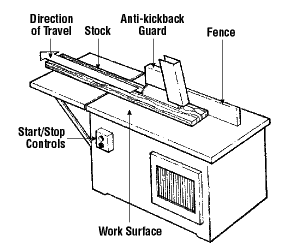Woodworking Machines - Table Saws
On this page
What should you do before using a table saw?
Back to topA table saw can be dangerous if not used properly.
- Read the owner's manual carefully.
- Make sure you understand instructions before attempting to use any tool or machine.
- Learn the applications and limitations before use.
- Refer to Woodworking Machines - General Safety Tips for general safety precautions.
What safety procedures should you follow when using a table saw?
Back to top- Wear safety glasses with side shield or safety goggles, or a face shield (with safety glasses or goggles).
- Wear hearing protection that is suitable for the level and frequency of the noise you are exposed to in the woodworking area.
- Wear protective footwear, when required.
- Wear respiratory protection, when required.
- Pay particular attention to the manufacturer's instructions on reducing the risk of kickback (when the wood can be violently thrown back toward the operator).
- Choose the proper blades for the type of work being done.
- Keep the blades clean, sharp, and properly set so that they will cut freely without having to force the work piece against the blade.
- Use the guards provided with the saw or ones designed for use with the saw that you are using. Keep them in place and in good working condition.
- Use a guard that is high enough to cover the part of the blade rising above the stock and wide enough to cover the blade when it is tilted. The blade height should be set so it does not extend more than about 3 mm (1/8 in) above the height of the piece being cut.
- Ensure that the fence is locked in position after the desired width has been set.
- Hold the work piece firmly down on the table and against the fence when pushing the wood through.
- Ensure that there is adequate support to hold a work piece; use extension tables or roller supports at the side or back for larger pieces. If an assistant is at the back (outfeed) end of the saw, an extension table should be in place so the back edge is about 1.2 m (4 ft) from the saw blade. The assistant should wait for the work piece to reach the edge of the extension table and should not reach toward the saw blade.
- Feed stock into the blade against the direction of its rotation.

- Move the rip fence out of the way when cross cutting. Never use it as a cut off gauge.
- Use a push stick when ripping narrow or short stock (e.g., when the fence is set less than about 15 cm (6 in) from the blade; when the piece is less than 30 cm (12 in) long or when the last 30 cm (12 in) of a longer piece is being cut). Refer to ripping applications in the manufacturer's instruction manual. See Woodworking Machines - Push Sticks for more information on push stick design.
- Use the push stick to remove the cut piece from between the fence and the blade.
- Keep hands out of the line of a saw blade.
- Use guard with a spreader (riving knife) and anti-kickback fingers for all ripping or cross cutting operations.
- Keep the body and face to one side of the saw blade out of the line of a possible kickback.
- Provide adequate support to the rear and sides of a saw table for wide or long stock.
- Be careful when waxing, cleaning, or servicing the table.
- Turn off the power and unplug (or lock out) a saw before doing any work on the saw.
- Keep area clean and clutter-free. Operate machines in a non-congested, well-lit area.
- Use the proper sawdust exhaust systems as required by operation.

What should you avoid when working with a table saw?
Back to topDo not saw freehand. Always hold the stock firmly against the mitre gauge or a rip fence to position and guide the cut.
- Do not reach around and over moving blades.
- Do not feed the work piece faster than the saw can accept.
- Do not lift the guard or work near the blade while it is turning.
- Do not cut stock that has loose knots, splits, defects or foreign objects (e.g., metal, stone) in it.
- Do not remove saw dust or cuttings around knives by hand or with compressed air. Use a stick or brush.
- Do not leave a saw running unattended. Turn off the power and make sure the machine has stopped running before leaving the area.
- Fact sheet last revised: 2019-08-09
